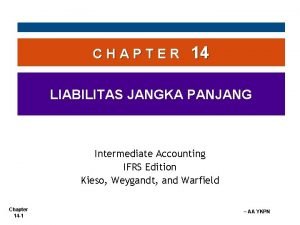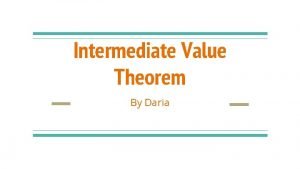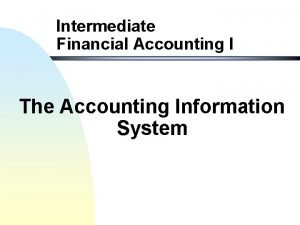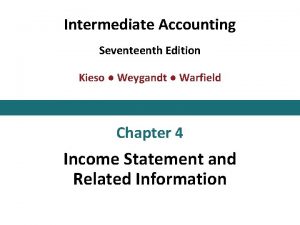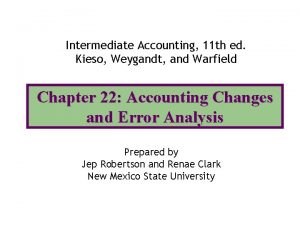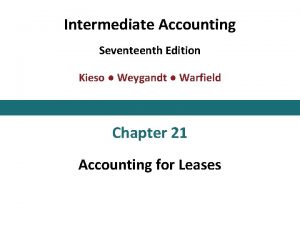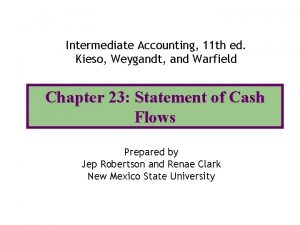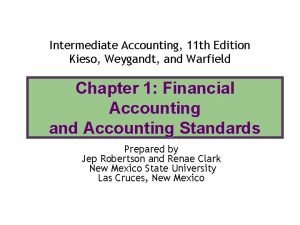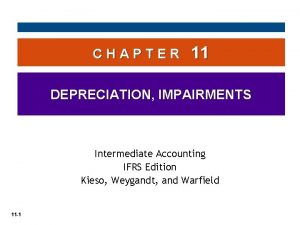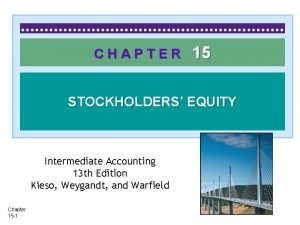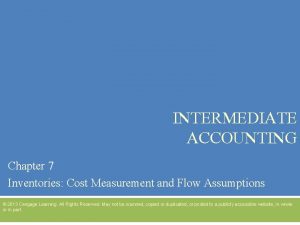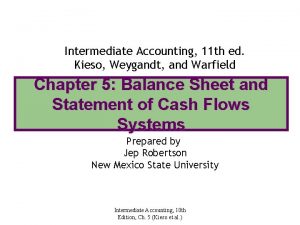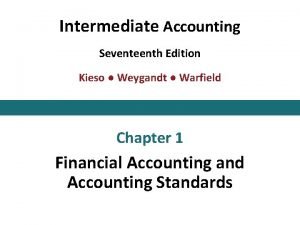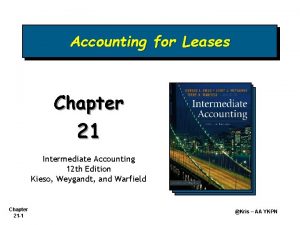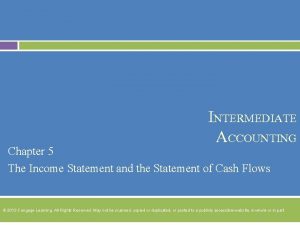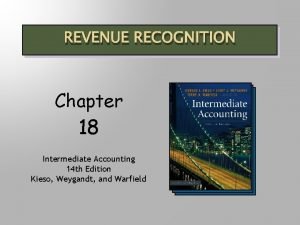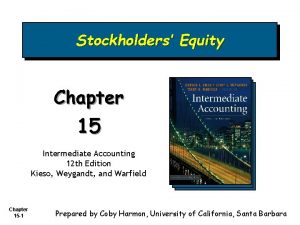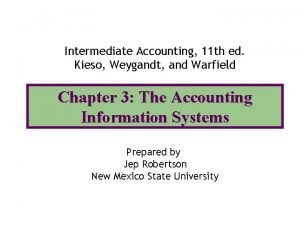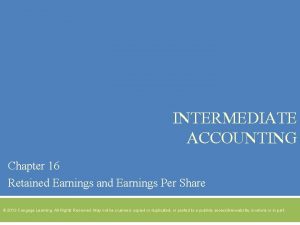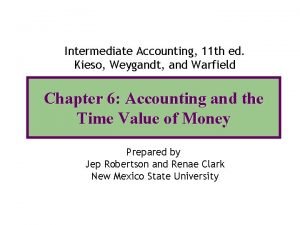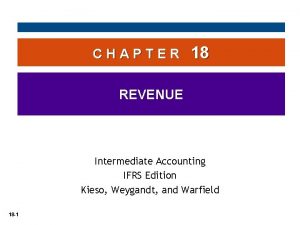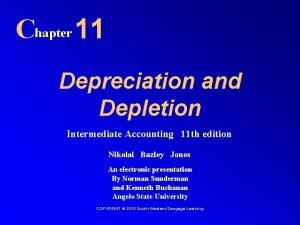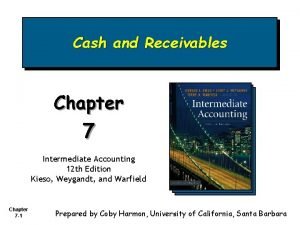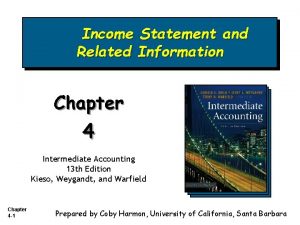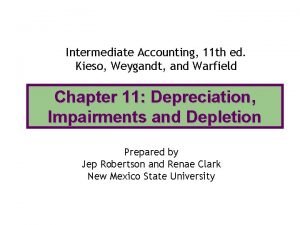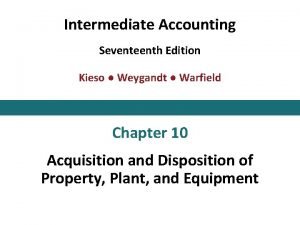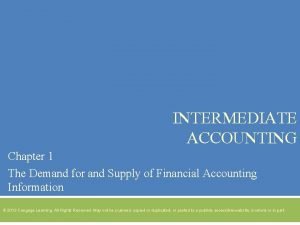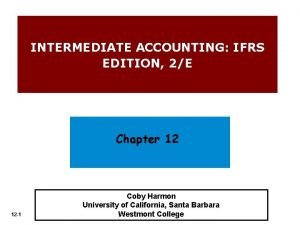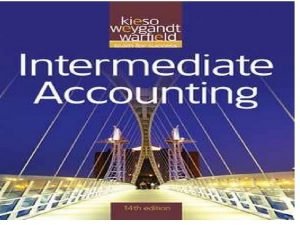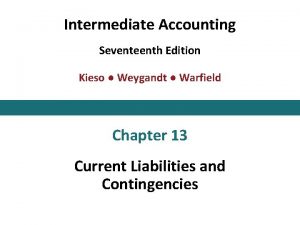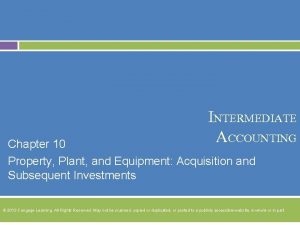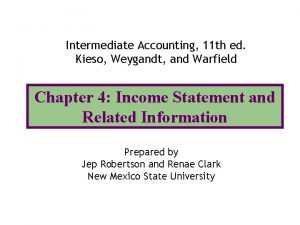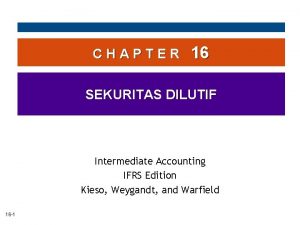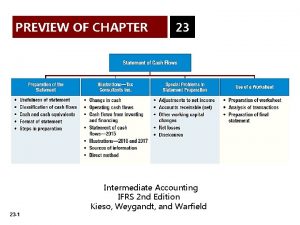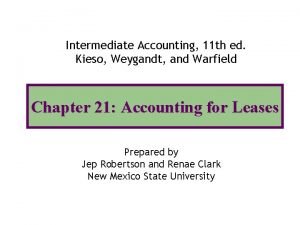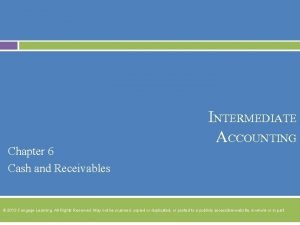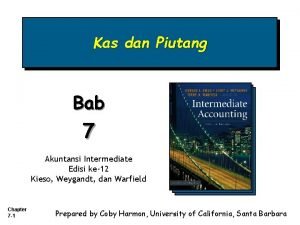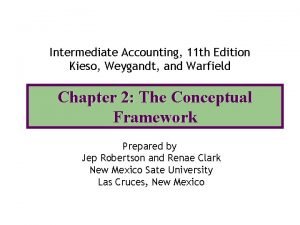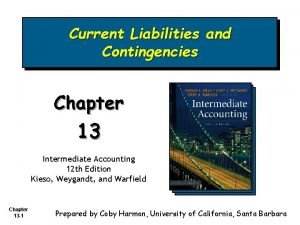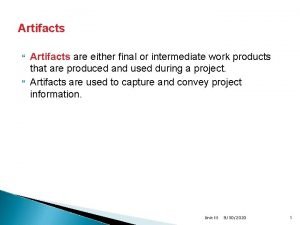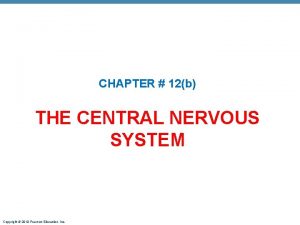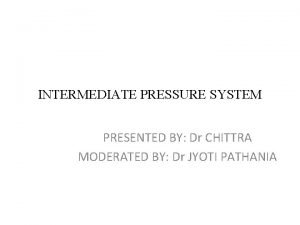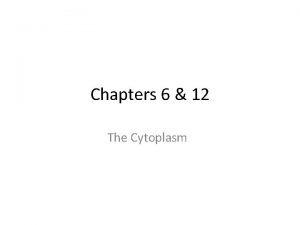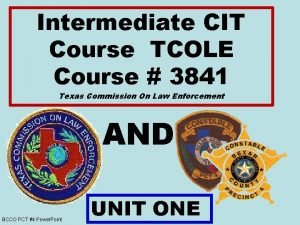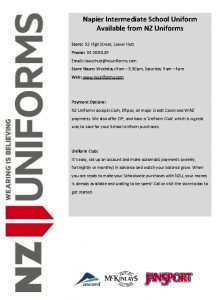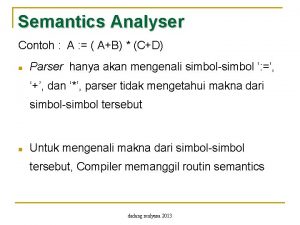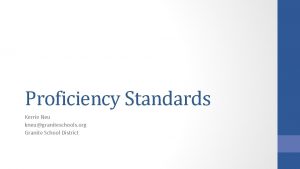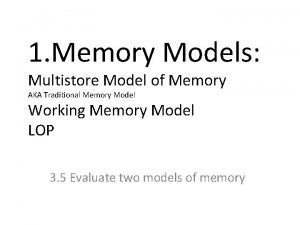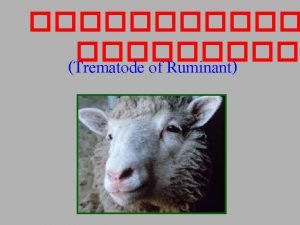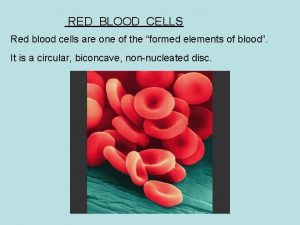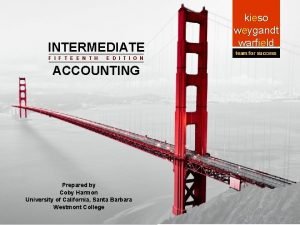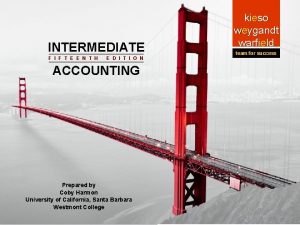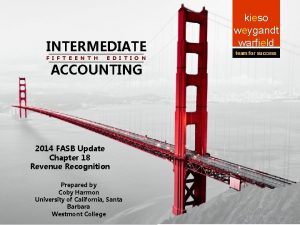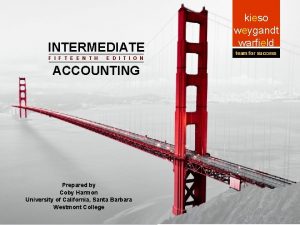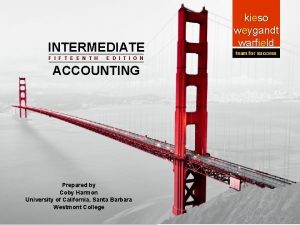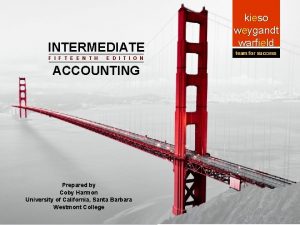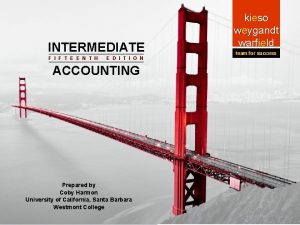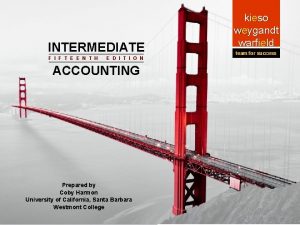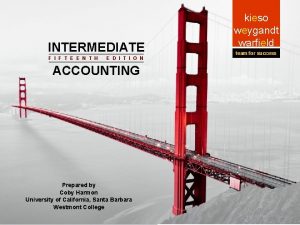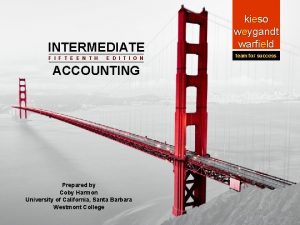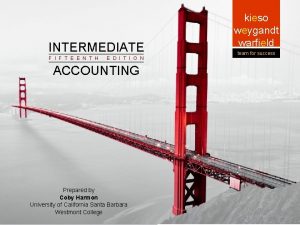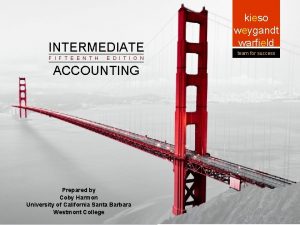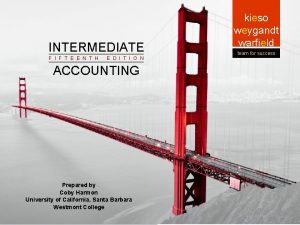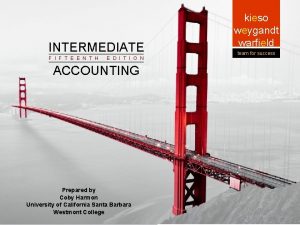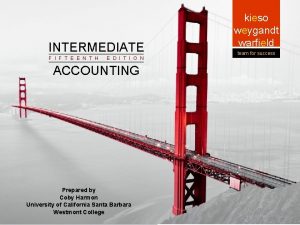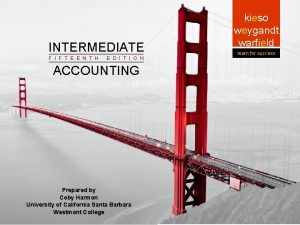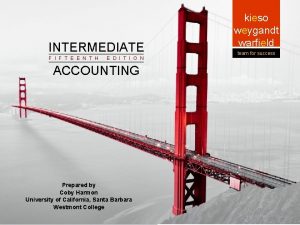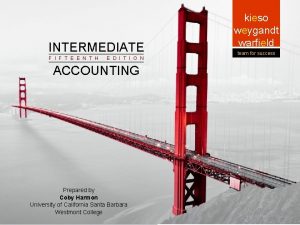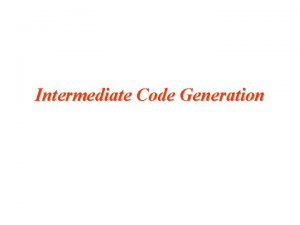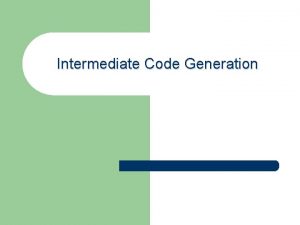INTERMEDIATE Intermediat ACCOUNTING Intermediat e e Accounting F

















































































- Slides: 81

INTERMEDIATE Intermediat ACCOUNTING Intermediat e e Accounting F I F T E E N T H 9 -1 E D I T I O N Prepared by Coby Harmon Prepared by University of California, Barbara. Prepared by Coby. Santa Harmon Westmont College Santa. Coby University of California, Barbara University of California, Santa Barbara Westmont College kieso weygandt warfield team for success

PREVIEW OF CHAPTER 9 Intermediate Accounting 15 th Edition Kieso Weygandt Warfield 9 -2

9 Inventories: Additional Valuation Issues LEARNING OBJECTIVES After studying this chapter, you should be able to: 9 -3 1. Describe and apply the lower-of-cost-ormarket rule. 5. Determine ending inventory by applying the gross profit method. 2. Explain when companies value inventories at net realizable value. 6. Determine ending inventory by applying the retail inventory method. 3. Explain when companies use the relative sales value method to value inventories. 7. Explain how to report and analyze inventory. 4. Discuss accounting issues related to purchase commitments.

Lower-of-Cost-or-Market A company abandons the historical cost principle when the future utility (revenue-producing ability) of the asset drops below its original cost. 9 -4 u Market = Replacement Cost. u Value goods at cost or cost to replace, whichever is lower. u Loss should be recorded when loss occurs, not in the period of sale. LO 1 Describe and apply the lower-of-cost-or-market rule.

Lower-of-Cost-or-Market Illustration 9 -1 Lower -of-Cost-or-Market Disclosures 9 -5 LO 1

Lower-of-Cost-or-Market Ceiling and Floor Why use Replacement Cost (RC) for Market? u Decline in the RC usually = decline in selling price. u RC allows a consistent rate of gross profit. u If reduction in RC fails to indicate reduction in utility, then two additional valuation limitations are used: 9 -6 ► Ceiling - net realizable value and ► Floor - net realizable value less a normal profit margin. LO 1 Describe and apply the lower-of-cost-or-market rule.

Lower-of-Cost-or-Market Net realizable value (NRV) is the estimated selling price in the ordinary course of business, less reasonably predictable costs of completion and disposal (often referred to as net selling price). Illustration 9 -2 9 -7 LO 1 Describe and apply the lower-of-cost-or-market rule.

Lower-of-Cost-or-Market Illustration 9 -3 What is the rationale for the Ceiling and Floor limitations? Ceiling = NRV Not > Cost Market Replacement Cost Not < GAAP LCM 9 -8 Floor = NRV less Normal Profit Margin LO 1 Describe and apply the lower-of-cost-or-market rule.

Lower-of-Cost-or-Market What is the rationale for the Ceiling and Floor limitations? 9 -9 u Ceiling – prevents overstatement of the value of obsolete, damaged, or shopworn inventories. u Floor – deters understatement of inventory and overstatement of the loss in the current period. LO 1 Describe and apply the lower-of-cost-or-market rule.

Lower-of-Cost-or-Market How Lower-of-Cost-or-Market Works Illustration 9 -5 9 -10 Advance slide in presentation mode to reveal answers. LO 1 Describe and apply the lower-of-cost-or-market rule.

Lower-of-Cost-or-Market Methods of Applying Lower-of-Cost-or-Market Illustration 9 -6 9 -11 Advance slide in presentation mode to reveal answers. LO 1 Describe and apply the lower-of-cost-or-market rule.

Lower-of-Cost-or-Market Recording “Market” Instead of Cost Ending inventory (cost) Ending inventory (market) Adjustment to LCM 9 -12 $ 82, 000 70, 000 $ 12, 000 Loss Method Loss Due to Decline in Inventory COGS Method Cost of Goods Sold 12, 000 Allowance to Reduce Inventory to Market Inventory 12, 000 LO 1 Describe and apply the lower-of-cost-or-market rule.

Lower-of-Cost-or-Market Balance Sheet 9 -13 LO 1 Describe and apply the lower-of-cost-or-market rule.

Lower-of-Cost-or-Market Income Statement 9 -14 LO 1

Lower-of-Cost-or-Market Illustration: Remmers Company manufactures desks. The company attempts to obtain a 20% gross margin on selling price. At December 31, 2014, the following finished desks appear in the company’s inventory. The 2014 catalog was in effect through November 2014, and the 2015 catalog is effective as of December 1, 2015. Instructions: At what amount should each of the four desks appear in the company’s December 31, 2015, inventory, assuming that the company has adopted a lower-of-FIFO-cost-or-market approach for valuation of inventories on an individual-item basis? 9 -15 LO 1

Lower-of-Cost-or-Market Ceiling = 450 (500 – 50) Not > Replacement Cost = 460 Cost = 470 Market = 450 Not < Floor = 350 (450 -(500 x 20%)) LCM = 450 9 -16 LO 1

Lower-of-Cost-or-Market Ceiling = 480 (540 – 60) Not > Replacement Cost = 430 Cost = 450 Market = 430 Not < Floor = 372 (480 -(540 x 20%)) LCM = 430 9 -17 LO 1

Lower-of-Cost-or-Market Ceiling = 820 (900 – 80) Not > Replacement Cost = 610 Cost = 830 Market = 640 Not < Floor = 640 (820 -(900 x 20%)) LCM = 640 9 -18 LO 1

Lower-of-Cost-or-Market Ceiling = 1, 070 (1, 200 – 130) Not > Replacement Cost = 1, 000 Cost = 960 Market = 1, 000 Not < Floor = 830 (1, 070 -(1, 200 x 20%)) LCM = 960 9 -19 LO 1

Lower-of-Cost-or-Market Use of an Allowance—Multiple Periods In general, accountants leave the allowance account on the books. They merely adjust the balance at the next year-end to agree with the discrepancy between cost and the lower-of-costor-market at that balance sheet date. Illustration 9 -10 9 -20 LO 1 Describe and apply the lower-of-cost-or-market rule.

Lower-of-Cost-or-Market Evaluation of Lower-of-Cost-or-Market Rule Some Deficiencies: 9 -21 u Expense recorded when loss in utility occurs. Profit on sale recognized at the point of sale. u Inventory valued at cost in one year and at market in the next year. u Net income in year of loss is lower. Net income in subsequent period may be higher than normal if expected reductions in sales price do not materialize. u LCM uses a “normal profit” in determining inventory values, which is a subjective measure. LO 1 Describe and apply the lower-of-cost-or-market rule.

9 Inventories: Additional Valuation Issues LEARNING OBJECTIVES After studying this chapter, you should be able to: 9 -22 1. Describe and apply the lower-of-cost-ormarket rule. 5. Determine ending inventory by applying the gross profit method. 2. Explain when companies value inventories at net realizable value. 6. Determine ending inventory by applying the retail inventory method. 3. Explain when companies use the relative sales value method to value inventories. 7. Explain how to report and analyze inventory. 4. Discuss accounting issues related to purchase commitments.

Valuation Bases Valuation at Net Realizable Value Permitted by GAAP under the following conditions: (1) a controlled market with a quoted price applicable to all quantities, and (2) no significant costs of disposal or (3) too difficult to obtain cost figures. 9 -23 LO 2 Explain when companies value inventories at net realizable value.

9 Inventories: Additional Valuation Issues LEARNING OBJECTIVES After studying this chapter, you should be able to: 9 -24 1. Describe and apply the lower-of-cost-ormarket rule. 5. Determine ending inventory by applying the gross profit method. 2. Explain when companies value inventories at net realizable value. 6. Determine ending inventory by applying the retail inventory method. 3. Explain when companies use the relative sales value method to value inventories. 7. Explain how to report and analyze inventory. 4. Discuss accounting issues related to purchase commitments.

Valuation Bases Valuation Using Relative Sales Value Used when buying varying units in a single lump-sum purchase. Illustration: Woodland Developers purchases land for $1 million that it will subdivide into 400 lots. These lots are of different sizes and shapes but can be roughly sorted into three groups graded A, B, and C. As Woodland sells the lots, it apportions the purchase cost of $1 million among the lots sold and the lots remaining on hand. Calculate the cost of lots sold and gross profit. 9 -25 LO 3 Explain when companies use the relative sales value method to value inventories.

Valuation Bases Illustration 9 -11 Allocation of Costs, Using Relative Sales Value Illustration 9 -12 Determination of Gross Profit, Using Relative Sales Value 9 -26 LO 3 Explain when companies use the relative sales value method to value inventories.

9 Inventories: Additional Valuation Issues LEARNING OBJECTIVES After studying this chapter, you should be able to: 9 -27 1. Describe and apply the lower-of-cost-ormarket rule. 5. Determine ending inventory by applying the gross profit method. 2. Explain when companies value inventories at net realizable value. 6. Determine ending inventory by applying the retail inventory method. 3. Explain when companies use the relative sales value method to value inventories. 7. Explain how to report and analyze inventory. 4. Discuss accounting issues related to purchase commitments.

Valuation Bases Purchase Commitments—A Special Problem ► Generally seller retains title to the merchandise. ► Buyer recognizes no asset or liability. ► If material, the buyer should disclose contract details in note in the financial statements. ► If the contract price is greater than the market price, and the buyer expects that losses will occur when the purchase is effected, the buyer should recognize losses in the period during which such declines in market prices take place. 9 -28 LO 4 Discuss accounting issues related to purchase commitments.

Valuation Bases Illustration: St. Regis Paper Co. signed timber-cutting contracts to be executed in 2015 at a price of $10, 000. Assume further that the market price of the timber cutting rights on December 31, 2014, dropped to $7, 000. St. Regis would make the following entry on December 31, 2014. Unrealized Holding Gain or Loss—Income 3, 000 Estimated Liability on Purchase Commitment 3, 000 Other expenses and losses in the Income statement. Current liabilities on the balance sheet. 9 -29 LO 4 Discuss accounting issues related to purchase commitments.

Valuation Bases Illustration: When St. Regis cuts the timber at a cost of $10 million, it would make the following entry. Purchases (Inventory) 7, 000 Est. Liability on Purchase Commitment 3, 000 Cash 10, 000 Assume the Congress permitted St. Regis to reduce its contract price and therefore its commitment by $1, 000. Est. Liability on Purchase Commitment 1, 000 Unrealized Holding Gain or Loss—Income 9 -30 1, 000 LO 4 Discuss accounting issues related to purchase commitments.

9 Inventories: Additional Valuation Issues LEARNING OBJECTIVES After studying this chapter, you should be able to: 9 -31 1. Describe and apply the lower-of-cost-ormarket rule. 5. Determine ending inventory by applying the gross profit method. 2. Explain when companies value inventories at net realizable value. 6. Determine ending inventory by applying the retail inventory method. 3. Explain when companies use the relative sales value method to value inventories. 7. Explain how to report and analyze inventory. 4. Discuss accounting issues related to purchase commitments.

Gross Profit Method of Estimating Inventory Substitute Measure to Approximate Inventory 1. Beginning inventory plus purchases equal total goods to be accounted for. 2. Goods not sold must be on hand. 3. The sales, reduced to cost, deducted from the sum of the opening inventory plus purchases, equal ending inventory. 9 -32 LO 5 Determine ending inventory by applying the gross profit method.

Gross Profit Method Illustration: Cetus Corp. has a beginning inventory of $60, 000 and purchases of $200, 000, both at cost. Sales at selling price amount to $280, 000. The gross profit on selling price is 30 percent. Cetus applies the gross margin method as follows. Illustration 9 -14 9 -33 LO 5 Determine ending inventory by applying the gross profit method.

Gross Profit Method Computation of Gross Profit Percentage Illustration: In Illustration 9 -14, the gross profit was a given. But how did Cetus derive that figure? To see how to compute a gross profit percentage, assume that an article cost $15 and sells for $20, a gross profit of $5. Illustration 9 -15 9 -34 LO 5 Determine ending inventory by applying the gross profit method.

Gross Profit Method Illustration 9 -16 Formulas Relating to Gross Profit Illustration 9 -17 Application of Gross Profit Formulas 9 -35 LO 5

Gross Profit Method Illustration: Astaire Company uses the gross profit method to estimate inventory for monthly reporting purposes. Presented below is information for the month of May. Instructions: (a) Compute the estimated inventory at May 31, assuming that the gross profit is 25% of sales. (b) Compute the estimated inventory at May 31, assuming that the gross profit is 25% of cost. 9 -36 LO 5

Gross Profit Method (a) Compute the estimated inventory at May 31, assuming that the gross profit is 25% of sales. 9 -37 LO 5 Determine ending inventory by applying the gross profit method.

Gross Profit Method (b) Compute the estimated inventory at May 31, assuming that the gross profit is 25% of cost. 25% 100% + 25% 9 -38 = 20% of sales LO 5 Determine ending inventory by applying the gross profit method.

Gross Profit Method Evaluation of Gross Profit Method Disadvantages: (1) Provides an estimate of ending inventory. (2) Uses past percentages in calculation. (3) A blanket gross profit rate may not be representative. (4) Normally unacceptable for financial reporting purposes. GAAP requires a physical inventory as additional verification. 9 -39 LO 5 Determine ending inventory by applying the gross profit method.

THE SQUEEZE WHAT’S YOUR PRINCIPLE Managers and analysts closely follow gross profits. A small change in the gross profit rate can significantly affect the bottom line. In 1993, Apple suffered a textbook case of shrinking gross profits. In response to pricing wars in the personal computer market, Apple had to quickly reduce the price of its signature Macintosh computers —reducing prices more quickly than it could reduce its costs. As a result its percent in 1992 to 40 percent in 1993. Though the drop of 4 percent seems small, its impact on the bottom line caused Apple’s stock price to drop from $57 per share on June 1, 1993, to $27. 50 by mid-July 1993. As another, more recent example, Nike—the largest global manufacturer of athletic footwear—in a recent quarter reported 9 -40 earnings that indicated falling gross profit, leading market analysts to adjust Nike’s price downward. The cause—continuing downward pressure on its gross profit. On the positive side, an increase in the gross profit rate provides a positive signal to the market. For example, just a 1 percent boost in Dr. Pepper’s gross profit rate cheered the market, indicating the company was able to avoid the squeeze of increased commodity costs by raising its prices. Source: Trefis, “Nike’s Earnings Reiterate Gross Margin Pressure, ” http: //seekingalpha. com (March 23, 2011); and D. Kardous, “Higher Pricing Helps Boost Dr. Pepper Snapple’s Net, ” Wall Street Journal Online (June 5, 2008). LO 5

9 Inventories: Additional Valuation Issues LEARNING OBJECTIVES After studying this chapter, you should be able to: 9 -41 1. Describe and apply the lower-of-cost-ormarket rule. 5. Determine ending inventory by applying the gross profit method. 2. Explain when companies value inventories at net realizable value. 6. Determine ending inventory by applying the retail inventory method. 3. Explain when companies use the relative sales value method to value inventories. 7. Explain how to report and analyze inventory. 4. Discuss accounting issues related to purchase commitments.

Retail Inventory Method A method used by retailers, to value inventory without a physical count, by converting retail prices to cost. Requires retailers to keep: (1) Total cost and retail value of goods purchased. (2) Total cost and retail value of the goods available for sale. (3) Sales for the period. Methods u Conventional Method Cost Method u LIFO Retail u Dollar-value LIFO u 9 -42 LO 6 Determine ending inventory by applying the retail inventory method.

Retail Inventory Method Illustration: Fuque Inc. uses the retail inventory method to estimate ending inventory for its monthly financial statements. The following data pertain to a single department for the month of October. Instructions: Prepare a schedule computing estimate retail inventory using the following methods: (1) Conventional (LCM) (2) Cost 9 -43 LO 6 Determine ending inventory by applying the retail inventory method.

Retail Inventory Method / 9 -44 = LO 6 Determine ending inventory by applying the retail inventory method.

Retail Inventory Method / 9 -45 = LO 6 Determine ending inventory by applying the retail inventory method.

Retail Inventory Method Special Items Relating to Retail Method 9 -46 u Freight costs u Purchase returns u Purchase discounts and allowances u Transfers-in u Normal shortages u Abnormal shortages u Employee discounts When sales are recorded gross, companies do not recognize sales discounts. LO 6 Determine ending inventory by applying the retail inventory method.

Retail Inventory Method Special Items Illustration 9 -23 9 -47 LO 6

Retail Inventory Method Evaluation of Retail Inventory Method Used for the following reasons: 1) To permit the computation of net income without a physical count of inventory. 2) Control measure in determining inventory shortages. 3) Regulating quantities of merchandise on hand. 4) Insurance information. Some companies refine the retail method by computing inventory separately by departments or class of merchandise with similar gross profits. 9 -48 LO 6 Determine ending inventory by applying the retail inventory method.

9 Inventories: Additional Valuation Issues LEARNING OBJECTIVES After studying this chapter, you should be able to: 9 -49 1. Describe and apply the lower-of-cost-ormarket rule. 5. Determine ending inventory by applying the gross profit method. 2. Explain when companies value inventories at net realizable value. 6. Determine ending inventory by applying the retail inventory method. 3. Explain when companies use the relative sales value method to value inventories. 7. Explain how to report and analyze inventory. 4. Discuss accounting issues related to purchase commitments.

Presentation and Analysis Presentation of Inventories Accounting standards require disclosure of: 1) Composition of the inventory, inventory financing arrangements, and the inventory costing methods employed. 2) Consistent application of costing methods from one period to another. 3) Inventory composition either in the balance sheet or in a separate schedule in the notes. 9 -50 LO 7 Explain how to report and analyze inventory.

Presentation and Analysis Presentation of Inventories Accounting standards require disclosure of: 4) Significant or unusual financing arrangements relating to inventories. 5) Inventories pledged as collateral for a loan in the current assets section rather than as an offset to the liability. 6) Basis on which it states inventory amounts (lower of-costor-market) and the method used in determining cost (LIFO, FIFO, average cost, etc. ). 9 -51 LO 7 Explain how to report and analyze inventory.

Presentation and Analysis Presentation of Inventories Illustration 9 -24 Disclosure of Inventory Methods 9 -52 LO 7 Explain how to report and analyze inventory.

Presentation and Analysis Presentation of Inventories 9 -53 Illustration 9 -25 Disclosure of Trade Practice in Valuing Inventories LO 7

Presentation and Analysis of Inventories Common ratios used in the management and evaluation of inventory levels are inventory turnover and average days to sell the inventory. 9 -54 LO 7 Explain how to report and analyze inventory.

Presentation and Analysis Inventory Turnover Ratio Measures the number of times on average a company sells the inventory during the period. Illustration: In its 2011 annual report Kellogg Company reported a beginning inventory of $1, 056 million, an ending inventory of $1, 132 million, and cost of goods sold of $7, 750 million for the year. Illustration 9 -26 9 -55 LO 7 Explain how to report and analyze inventory.

Presentation and Analysis Average Days to Sell Inventory Measure represents the average number of days’ sales for which a company has inventory on hand. Illustration 9 -26 Average Days to Sell 365 days / 7. 08 times = every 51. 5 days 9 -56 LO 7 Explain how to report and analyze inventory.

APPENDIX 9 A LIFO RETAIL METHODS Primary reason to use LIFO u Tax advantages. u Results in a better matching of costs and revenues. u The use of LIFO retail is made under two assumptions: 1. stable prices and 2. fluctuating prices. 9 -57 LO 8 Determine ending inventory by applying the LIFO retail methods.

APPENDIX 9 A LIFO RETAIL METHODS Stable Prices—LIFO Retail Method A major assumption of the LIFO retail method is that the markups and markdowns apply only to the goods purchased during the current period and not to the beginning inventory. 9 -58 LO 8 Determine ending inventory by applying the LIFO retail methods.

APPENDIX 9 A LIFO RETAIL METHODS Illustration: Fuque Inc. uses the retail inventory method to estimate ending inventory for its monthly financial statements. The following data pertain to a single department for the month of October. Instructions: Prepare a schedule computing estimate retail inventory using the LIFO Retail method. 9 -59 LO 8 Determine ending inventory by applying the LIFO retail methods.

APPENDIX 9 A LIFO RETAIL METHODS / 9 -60 = LO 8

APPENDIX 9 A LIFO RETAIL METHODS Illustration 9 A-1 LIFO Retail Method—Stable Prices 2014 9 -61 LO 8 Determine ending inventory by applying the LIFO retail methods.

APPENDIX 9 A LIFO RETAIL METHODS Illustration 9 A-2 Ending Inventory at LIFO Cost, 2014—Stable Prices Inventory is composed of two layers. 9 -62 Advance slide in presentation mode to reveal answers. LO 8 Determine ending inventory by applying the LIFO retail methods.

APPENDIX 9 A LIFO RETAIL METHODS Illustration 9 A-3 Ending Inventory at LIFO Cost, 2015—Stable Prices Notice that the 2014 layer is reduced from $11, 000 to $5, 000. 9 -63 Advance slide in presentation mode to reveal answers. LO 8 Determine ending inventory by applying the LIFO retail methods.

APPENDIX 9 A LIFO RETAIL METHODS Fluctuating Prices—Dollar-Value LIFO Retail If the price level does change, the company must eliminate the price change so as to measure the real increase in inventory, not the dollar increase. 9 -64 LO 8 Determine ending inventory by applying the LIFO retail methods.

APPENDIX 9 A LIFO RETAIL METHODS Illustration: Assume that the beginning inventory had a retail market value of $10, 000 and the ending inventory had a retail market value of $15, 000. Assume further that the price level has risen from 100 to 125. It is inappropriate to suggest that a real increase in inventory of $5, 000 has occurred. Instead, the company must deflate the ending inventory at retail. Illustration 9 A-4 *1. 25 = 125 ÷ 100 9 -65 LO 8 Determine ending inventory by applying the LIFO retail methods.

APPENDIX 9 A LIFO RETAIL METHODS Illustration: Assume that the current 2014 price index is 112 (prior year = 100) and that the inventory ($56, 000) has remained unchanged. Illustration 9 A-5 Dollar-Value LIFO Retail Method—Fluctuating Prices 9 -66

APPENDIX 9 A LIFO RETAIL METHODS Illustration: From this information, we compute the inventory amount at cost: Illustration 9 A-6 Hernandez must restate layers of a particular year to the prices in effect in the year when the layer was added. 9 -67 LO 8 Determine ending inventory by applying the LIFO retail methods.

APPENDIX 9 A LIFO RETAIL METHODS Difference between the LIFO approach (stable prices) and the dollar-value LIFO method. Illustration 9 A-7 Comparison of Effect of Price Assumptions The difference of $3, 780 results from an increase in the price of goods, not from an increase in the quantity of goods. 9 -68 LO 8 Determine ending inventory by applying the LIFO retail methods.

APPENDIX 9 A LIFO RETAIL METHODS Subsequent Adjustments under Dollar-Value LIFO Retail Illustration: Using the data from the previous example, assume that the retail value of the 2015 ending inventory at current prices is $64, 800, the 2015 price index is 120 percent of base-year, and the cost-to-retail percentage is 75 percent. Compute the ending inventory at LIFO cost. Illustration 9 A-8 9 -69 LO 8

APPENDIX 9 A LIFO RETAIL METHODS Subsequent Adjustments under Dollar-Value LIFO Retail Illustration: Conversely assume that in 2015 the ending inventory in base-year prices is $48, 000. Compute the ending inventory at LIFO cost. Illustration 9 A-9 9 -70 LO 8 Determine ending inventory by applying the LIFO retail methods.

APPENDIX 9 A LIFO RETAIL METHODS Changing from Conventional Retail to LIFO Illustration: Hackman Clothing Store employs the conventional retail method but wishes to change to the LIFO retail method beginning in 2015. The amounts shown by the firm’s books are as follows. 9 -71 LO 8 Determine ending inventory by applying the LIFO retail methods.

APPENDIX 9 A LIFO RETAIL METHODS Conventional Retail Inventory Method 9 -72 Illustration 9 A-10 LO 8

APPENDIX 9 A LIFO RETAIL METHODS Hakeman Clothing can then quickly approximate the ending inventory for 2014 under the LIFO retail method. Illustration 9 A-11 The difference of $500 ($11, 250 - $10, 750) between the LIFO retail method and the conventional retail method is the amount by which the company must adjust beginning inventory for 2015. 9 -73 LO 8 Determine ending inventory by applying the LIFO retail methods.

RELEVANT FACTS - Similarities 9 -74 u IFRS and GAAP account for inventory acquisitions at historical cost and evaluate inventory for lower-of-cost-or-market subsequent to acquisition. u Who owns the goods—goods in transit, consigned goods, special sales agreements—as well as the costs to include in inventory are essentially accounted for the same under IFRS and GAAP. LO 9 Compare the accounting procedures related to valuation of inventories under GAAP and IFRS.

RELEVANT FACTS - Differences 9 -75 u The requirements for accounting for and reporting inventories are more principles-based under IFRS. That is, GAAP provides more detailed guidelines in inventory accounting. u A major difference between IFRS and GAAP relates to the LIFO cost flow assumption. GAAP permits the use of LIFO for inventory valuation. IFRS prohibits use. FIFO and average-cost are the only two acceptable cost flow assumptions permitted under IFRS. Both sets of standards permit specific identification where appropriate. u In the lower-of-cost-or-market test for inventory valuation, IFRS defines market as net realizable value. GAAP, on the other hand, defines market as replacement cost subject to the constraints of net realizable value (the ceiling) and net realizable value less a normal markup (the floor). IFRS does not use a ceiling or a floor to determine market. LO 9

RELEVANT FACTS - Differences 9 -76 u Under GAAP, if inventory is written down under the lower-of-cost-ormarket valuation, the new basis is now considered its cost. As a result, the inventory may not be written back up to its original cost in a subsequent period. Under IFRS, the write-down may be reversed in a subsequent period up to the amount of the previous write-down. Both the write-down and any subsequent reversal should be reported on the income statement. u IFRS requires both biological assets and agricultural produce at the point of harvest to be reported at net realizable value. GAAP does not require companies to account for all biological assets in the same way. Furthermore, these assets generally are not reported at net realizable value. Disclosure requirements also differ between the two sets of standards. LO 9

ON THE HORIZON One issue that will be difficult to resolve relates to the use of the LIFO cost flow assumption. As indicated, IFRS specifically prohibits use. Conversely, the LIFO cost flow assumption is widely used in the United States because of its favorable tax advantages. In addition, many argue that LIFO from a financial reporting point of view provides a better matching of current costs against revenue and therefore enables companies to compute a more realistic income. 9 -77 LO 9 Compare the accounting procedures related to valuation of inventories under GAAP and IFRS.

IFRS SELF-TEST QUESTION All of the following are key similarities between GAAP and IFRS with respect to accounting for inventories except: a. costs to include in inventories are similar. b. LIFO cost flow assumption where appropriate is used by both sets of standards. c. fair value valuation of inventories is prohibited by both sets of standards. d. guidelines on ownership of goods are similar. 9 -78 LO 9 Compare the accounting procedures related to valuation of inventories under GAAP and IFRS.

IFRS SELF-TEST QUESTION All of the following are key differences between GAAP and IFRS with respect to accounting for inventories except the: a. definition of the lower-of-cost-or-market test for inventory valuation differs between GAAP and IFRS. b. average cost method is prohibited under IFRS. c. inventory basis determination for write-downs differs between GAAP and IFRS. d. guidelines are more principles based under IFRS than they are under GAAP. 9 -79 LO 9 Compare the accounting procedures related to valuation of inventories under GAAP and IFRS.

IFRS SELF-TEST QUESTION Under IFRS, agricultural activity results in which of the following types of assets? I. Agricultural produce II. Biological assets a. I only. b. II only. c. I and II. d. Neither I nor II. 9 -80 LO 9 Compare the accounting procedures related to valuation of inventories under GAAP and IFRS.

Copyright © 2013 John Wiley & Sons, Inc. All rights reserved. Reproduction or translation of this work beyond that permitted in Section 117 of the 1976 United States Copyright Act without the express written permission of the copyright owner is unlawful. Request for further information should be addressed to the Permissions Department, John Wiley & Sons, Inc. The purchaser may make back-up copies for his/her own use only and not for distribution or resale. The Publisher assumes no responsibility for errors, omissions, or damages, caused by the use of these programs or from the use of the information contained herein. 9 -81
 Chapter 14 intermediate accounting kieso bahasa indonesia
Chapter 14 intermediate accounting kieso bahasa indonesia Khan academy mean value theorem
Khan academy mean value theorem Subsidiary ledgers meaning
Subsidiary ledgers meaning Retained earnings ifrs
Retained earnings ifrs Intermediate accounting chapter 2
Intermediate accounting chapter 2 Intermediate accounting kieso
Intermediate accounting kieso Intermediate accounting
Intermediate accounting Chapter 21 accounting for leases
Chapter 21 accounting for leases Chapter 15 intermediate accounting
Chapter 15 intermediate accounting Cost of retained earnings
Cost of retained earnings Intermediate accounting chapter 17 investments test bank
Intermediate accounting chapter 17 investments test bank Intermediate accounting kieso
Intermediate accounting kieso Intermediate accounting
Intermediate accounting Intermediate accounting
Intermediate accounting First level of conceptual framework
First level of conceptual framework Direct financing
Direct financing Chapter 11 depreciation impairments and depletion
Chapter 11 depreciation impairments and depletion Property dividend
Property dividend Chapter 7 inventories answers
Chapter 7 inventories answers Drawback of financial accounting
Drawback of financial accounting Intermediate accounting kieso
Intermediate accounting kieso Gaap principles
Gaap principles Chapter 21 accounting for leases kieso terjemahan
Chapter 21 accounting for leases kieso terjemahan Income statement intermediate accounting
Income statement intermediate accounting Chapter 18 revenue recognition
Chapter 18 revenue recognition Chapter 17 intermediate accounting
Chapter 17 intermediate accounting Property dividend
Property dividend System of accounting
System of accounting Intermediate accounting chapter 16
Intermediate accounting chapter 16 Intermediate accounting kieso
Intermediate accounting kieso Chapter 18 kieso
Chapter 18 kieso Retail inventory method
Retail inventory method Chapter 11 depreciation impairments and depletion
Chapter 11 depreciation impairments and depletion Cash and receivables intermediate accounting
Cash and receivables intermediate accounting Chapter 4 income statement and related information
Chapter 4 income statement and related information Intermediate accounting kieso
Intermediate accounting kieso Commercial substance
Commercial substance Chapter 19 accounting for income taxes
Chapter 19 accounting for income taxes Intermediate accounting chapter 1
Intermediate accounting chapter 1 Financial accounting chapter 1
Financial accounting chapter 1 Patent impairment
Patent impairment Revenue recognition intermediate accounting
Revenue recognition intermediate accounting Equity adalah
Equity adalah Warranty journal entries
Warranty journal entries Intermediate accounting chapter 10
Intermediate accounting chapter 10 Intermediate accounting kieso
Intermediate accounting kieso Chapter 16 kieso
Chapter 16 kieso Intermediate accounting chapter 23
Intermediate accounting chapter 23 Chapter 3 intermediate accounting
Chapter 3 intermediate accounting Impairment of intangible assets
Impairment of intangible assets Intermediate accounting chapter 1
Intermediate accounting chapter 1 Capital lease 4 criteria
Capital lease 4 criteria Cash and receivables intermediate accounting
Cash and receivables intermediate accounting Chapter 7 accounting
Chapter 7 accounting Primary qualities of accounting information
Primary qualities of accounting information Chapter 13 intermediate accounting
Chapter 13 intermediate accounting Accounting for current liabilities and contingencies
Accounting for current liabilities and contingencies Advantages of computerized accounting system
Advantages of computerized accounting system What is accountin
What is accountin Responsibility accounting ppt
Responsibility accounting ppt Intermediate artifacts can be found at
Intermediate artifacts can be found at Dot
Dot Intermediate-risk surgery list
Intermediate-risk surgery list Pvis cotillion
Pvis cotillion Lentiform
Lentiform Intermediate directions
Intermediate directions ü
ü Cytoplasm
Cytoplasm Tcole cit training
Tcole cit training Esl jeopardy intermediate
Esl jeopardy intermediate Napier intermediate
Napier intermediate Vw miller intermediate
Vw miller intermediate Contoh semantics
Contoh semantics Novice intermediate advanced
Novice intermediate advanced Toxocara
Toxocara Intermediate processing psychology example
Intermediate processing psychology example The hard way out by terry vaughn genre
The hard way out by terry vaughn genre Fasciolidae
Fasciolidae Intermediate normoblast
Intermediate normoblast Opposite of yello
Opposite of yello Tcole 2106
Tcole 2106 Paragonimus westermani second intermediate host
Paragonimus westermani second intermediate host
